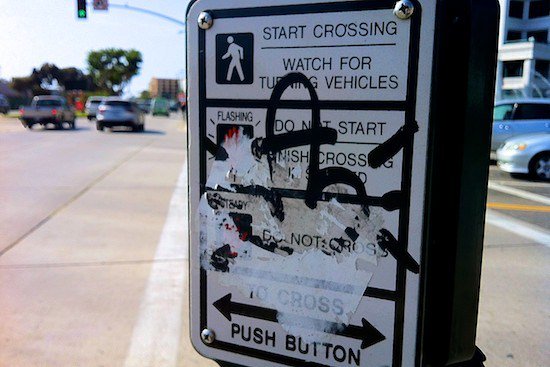Let’s talk for a moment about beg buttons…
First: beg buttons are NOT there to serve pedestrians. They exist to serve people in cars. They exist so that car traffic signals can minimize the car travel “delays” associated with people who need to cross a street on foot. (/1)
First: beg buttons are NOT there to serve pedestrians. They exist to serve people in cars. They exist so that car traffic signals can minimize the car travel “delays” associated with people who need to cross a street on foot. (/1)
In order to save people in cars from waiting upwards of 30 seconds for crosswalk signals, city traffic engineers force people on foot to press beg buttons and wait. Always waiting. It’s worth comparing the experience on foot versus behind the wheel. (/2)
People in cars either (a) have the green or (b) wait, typically under a minute, but longer at a few places. They’re in climate-controlled spaces, and the city has spent millions installing in-street coils to automatically detect them without any added effort by a driver. (/3)
Traffic lights are set up to minimize car delays (e.g. “Signal Sync”), with zero consideration for people walking or biking. However, a couple cities (not LA) have added “green wave” lights that align with biking speeds on key streets. (/4)
Cities like LA have installed beg buttons in part because they have widened their roads and, thus, the time to cross on foot is substantially greater than if those roads were narrower. People crossing on foot require ~3 seconds for each 10-11& #39; lane they must cross. (/5)
The dirty secret of road widenings is that they require longer ped crossing times. This, of course, undermines the whole “purpose” for adding lanes in the first place. It’s also why road “diets” actually can move more cars, because narrower roads have shorter red lights. (/6)
Beg buttons are a reflection of the lengths to which traffic engineers have gone to save people in their cars a few *seconds* here and there, at the expense of added *minutes* here and there for people walking. Beg buttons add minutes of delay for pedestrians. (/7)
Another example of this? All those intersections where there’s a “NO PED CROSSING” sign on one of the four crosswalks. That design saves drivers a minute, maybe two, max. Meanwhile, it forces people on foot to cross three legs of an intersection instead of only one. (/8)
In the past decade, LA has instituted two meaningful interventions designed to serve pedestrians and not drivers: (1) zebra-striped crosswalks and (2) Barnes-style all-way crosswalks (like at Hollywood and Highland). (/9)
That the former required a major lift to become City policy (even though it’s relatively cheap) and the latter has been implemented at maybe only a half-dozen crosswalks in a 500 square mile city says a lot about the priority we give to these life-saving interventions. (/10)
Meanwhile, @LADOTOfficial has been adding beg buttons at intersections all across the city, including (and this is the reason for this discussion in the first place) locations with so many pedestrians that it defies logic to even require them at all. (/11)
These actions defy logic, unless your priority is moving cars. And for those of us who walk on a daily basis, it is abundantly apparent that moving cars - above all else - is LA’s number one priority, and has been for many years. (/12)
Beg buttons are inconsistent in their timing, often quite dirty, hard to tell if they’re working, and also not ADA friendly, but then they don’t exist for people walking. Beg buttons exist to make the drives of people in their cars more convenient. (/end)

 Read on Twitter
Read on Twitter


